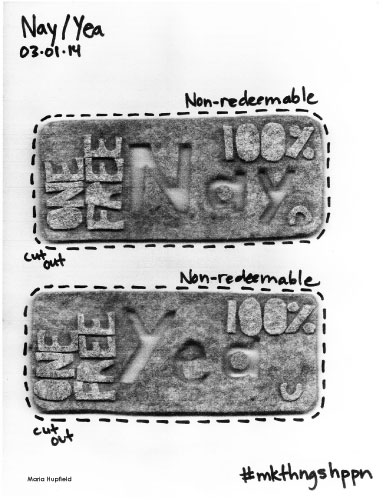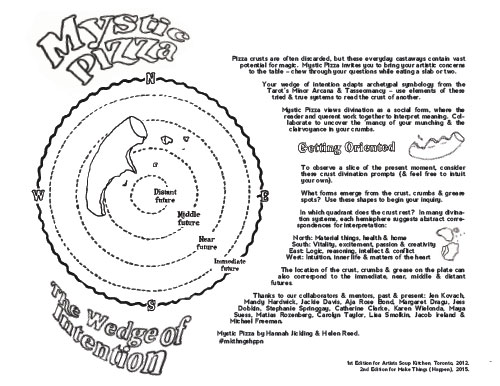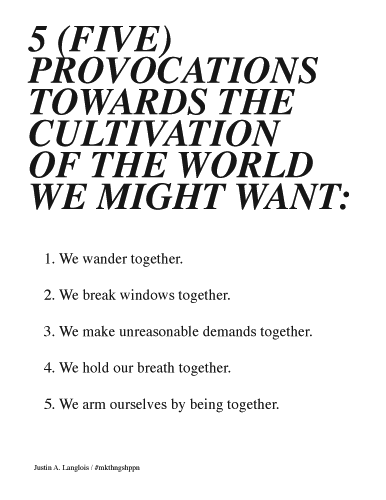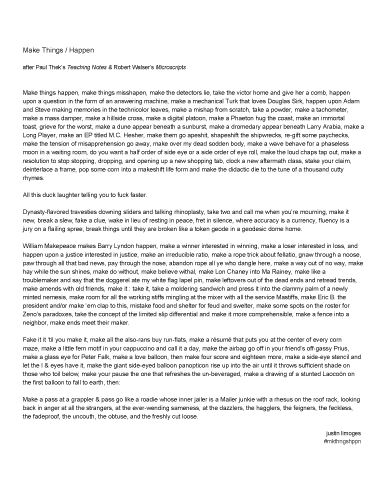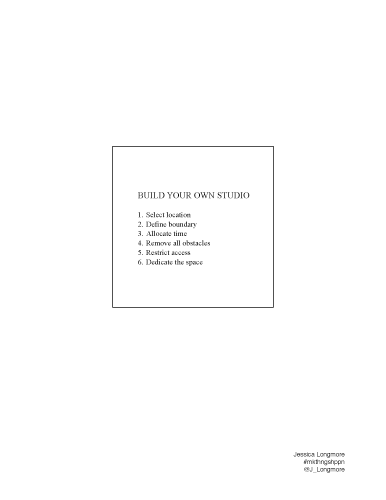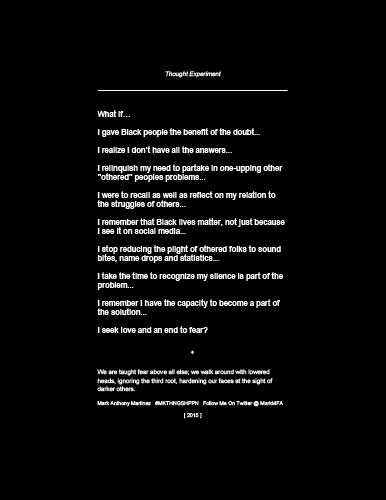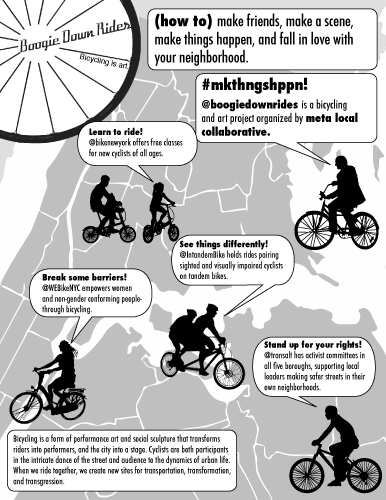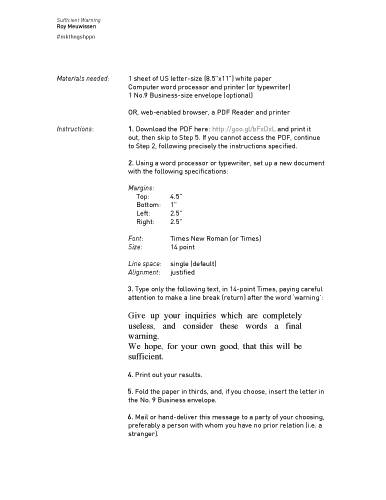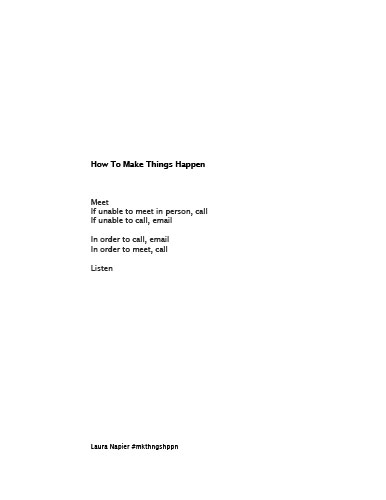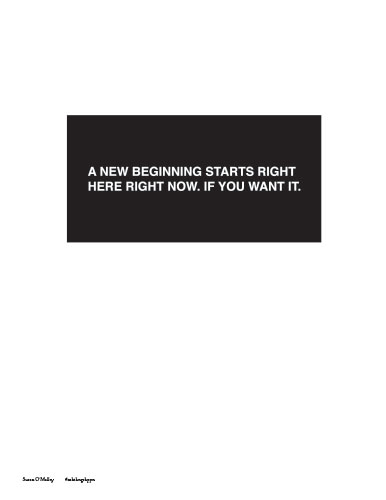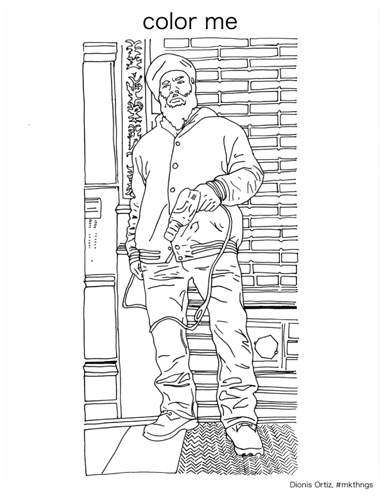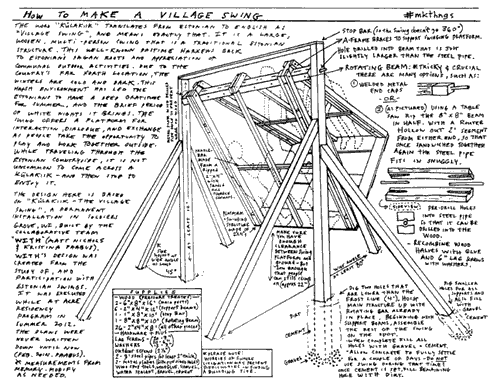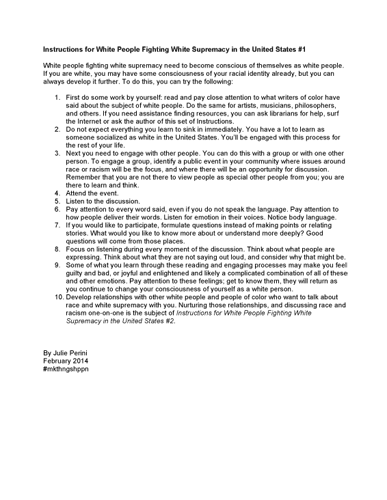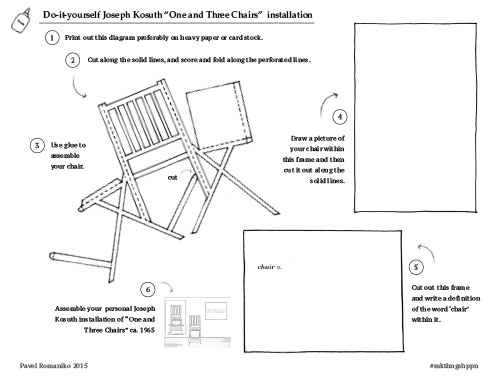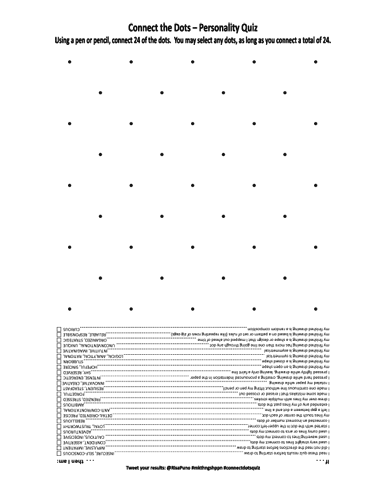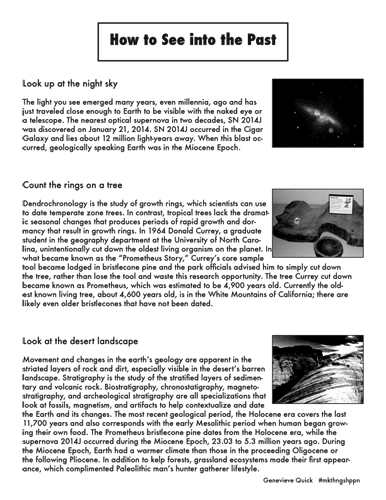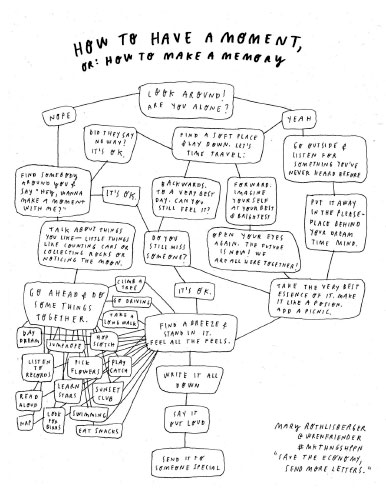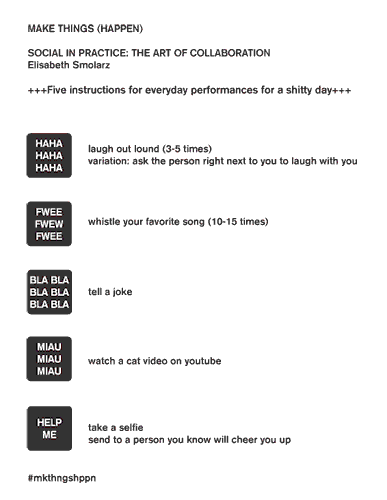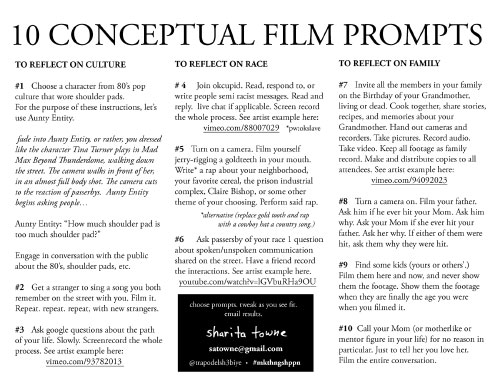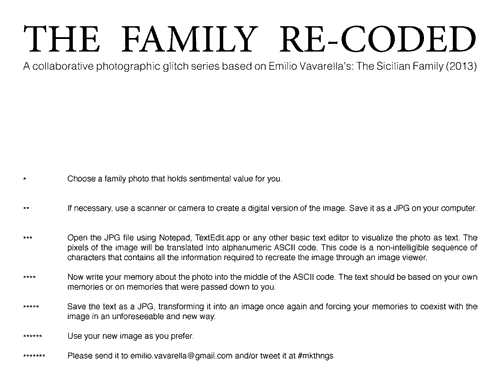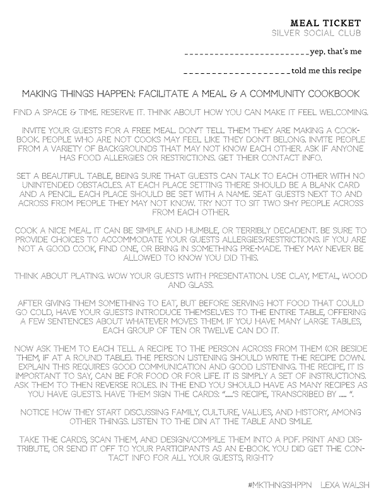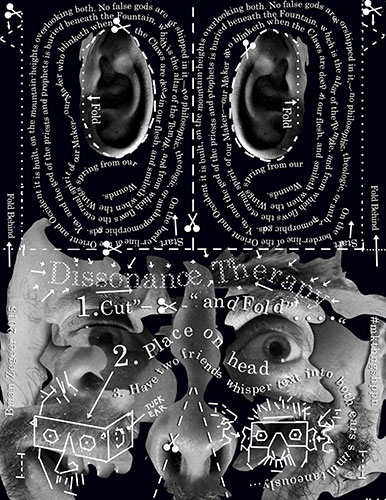
View activities and learn more about the artists.
Download individual activities below or the complete set (20.9 MB). Then, tweet your results to #mkthngshppn, where you can see other results.
Lauren F. Adams
My Commemorative Plate
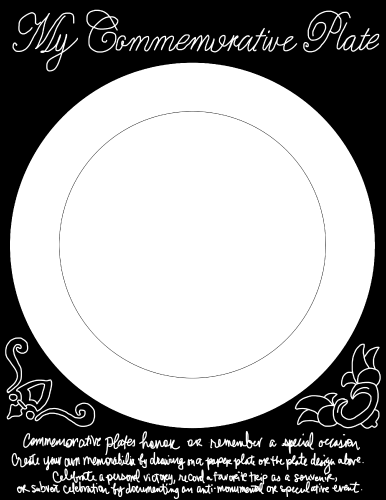
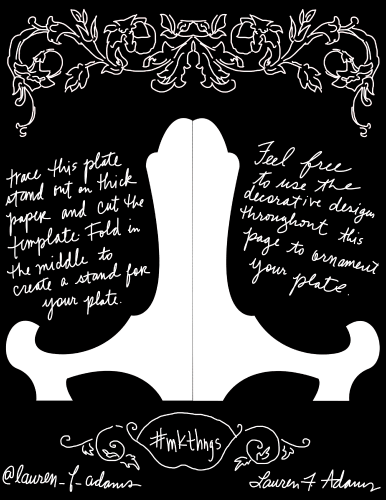
Download PDF.
Commemorative items make history monumental as decorative souvenirs. This prompt invites you to memorialize your own personal history, or make real what has been overlooked in history (or perhaps not even happened yet).
I mine the histories of power, labor, and material culture to make surprising connections that resonate with current sociopolitical issues. I am inspired by historical decorative forms and designs such as Chinoiserie-style wallpaper, Elizabethan-era textiles, and Soviet avant-garde agitprop.
Lauren Frances Adams lives in Baltimore, Maryland, where she is faculty at MICA. Recent solo exhibitions include Back Lane West, UK; Contemporary Art Museum St. Louis; EXPO Chicago; and Conner Contemporary. Group exhibitions include: Nymans House, UK; SECCA, NC; CUE Foundation, NY; Mattress Factory and the Andy Warhol Museum, PA. She attended Skowhegan and is a Joan Mitchell Foundation MFA Grant recipient. lfadams.com
Oliver Braid
The Bardic Tradition
“But as for pottery and basket weaving—what good are these? As soon as the doors of the evening institution clang shut behind you, you’re back where you started. On the way home you might get into an argument with a stranger on a street corner and you’re left saying “Well I can’t express myself—you’ll have to see my baskets.” (From “An Evening with Quentin Crisp,” 1981)
Hello, my name is Oliver Braid and I am an artist living in Glasgow. I was born 1984 in Birmingham and studied at Falmouth College of Arts and Glasgow School of Art. oliverbraid.com
Maurice Carlin
Primary Sources
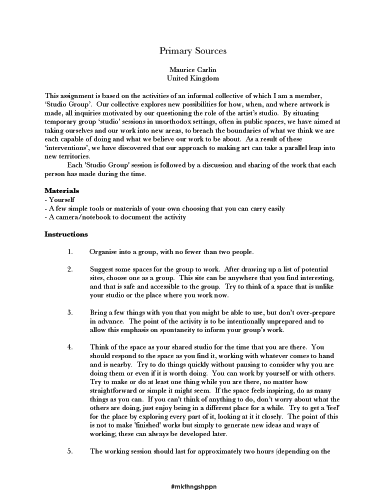
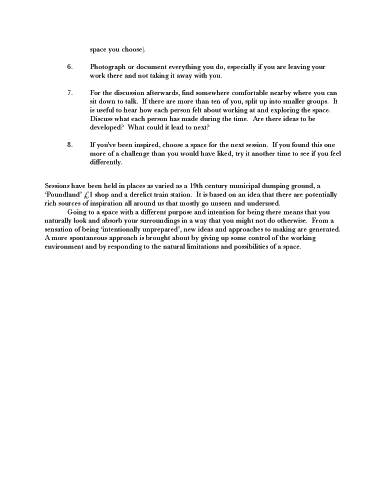
Download PDF.
This activity is based on the activities of an informal collective of which I am a member, ‘Studio Group.’ Our collective explores new possibilities for how, when, and where artwork is made, all inquiries motivated by our questioning the role of the artist’s studio.
My work merges performance, place, and publishing to produce dialogues between digital and physical experience. Artworks explore perceptions around the information we receive and send, whether derived from a TV screen, via the internet or through a day to day experience on the street.
Maurice Carlin is a Manchester based artist. His work has been featured in publications including Frieze, The Guardian, and Art Monthly. In 2007, he co-founded Islington Mill Art Academy, a peer-led experiment into alternative modes of art education. Recent shows include The Negligent Eye, The Bluecoat Gallery, Liverpool (2014); Self-Interruption, Jack Chiles Gallery, New York (2013); and First...Next...Then...Finally, Castlefield Gallery, Manchester (2013). mauricecarlin.com
Kevin B. Chen
Under construction
Under construction, a collaborative exercise for the general public to complete the construction of a fictional urban skyline with the most elemental tool—a graphite pencil.
Kevin B. Chen’s most recent visual work in collage and illustration investigates population growth and the world's largest metropolitan areas.
Kevin B. Chen has been involved in the Bay Area arts community for 20 years as a curator, visual artist, and writer. He is represented by Jack Fischer Gallery in San Francisco, CA. kevinbchen.com
Torreya Cummings
The Searchers
This project takes its title from the 1956 film starring John Wayne as a man intent on searching for his niece who was abducted by the Comanche and had adapted to their culture.
The plot is much more complicated than that, as is looking for jobs, housing, or love. We spend a lot of time searching for things on the internet. I’m also struck by the language around “manifesting” and other forms of magical thinking or “making things happen,” especially where it intersects with technology.
The work may take a broad a range of forms. Sculptures often function as props for performances, which can then become photographs. The recent focus of these investigations has been the idea of the “wild west” and the conflict between a cultural ideology of liberty and a practice of enclosure.
Torreya Cummings makes work in response to problems of history and place: How did we get here? Where are we going? And who is the “we” assumed by those questions?
Cummings holds an MFA in sculpture from the California College of the Arts, a BA from UC Davis, and is from California’s rural Central Valley. torreya.info
Helen de Main
Something I’ve been meaning to
Something I’ve been meaning to addresses personal and social responsibility, by attempting to overcome tactics of avoidance and putting things off. Consequent actions may vary from the mundane and trivial to those more significant and even potentially life changing.
Working in sculpture and printmaking, Helen de Main’s practice combines research processes with hands on approaches to making. Installations see entropic prints on paper and fabric alongside large-scale geometric forms.
Current research has been focussing on forms of activism and protest, with particular reference to the women’s movement.
Helen de Main is a visual artist based in Glasgow. She has a MFA from Glasgow School of Art and a BA (Hons) from Sheffield Hallam University. She has exhibited widely in the UK and internationally, including at Al Hoash Palestinian Art Court, Jerusalem; Overgaden Institute of Contemporary Art, Copenhagen; ReMap Athens; and Glasgow International Festival of Visual Art. helendemain.net
double zero
Call This Number
Call in for an interactive telecommunications experience.
double zero is the collective duo of Hannah Ireland and Annie Vought. Their interdisciplinary collaboration builds on a friendship of over twenty years and investigates how identity is shaped in relation to those closest to us, the boundaries and connections between individuals, and different modes of taking up space in the world.
Annie Vought and Hannah Ireland grew up together in Santa Fe, New Mexico. They have been collaborating as double zero for the past three years. Annie Vought received her MFA from Mills College in 2009 and was a recipient of the Murphy and Cadogan Contemporary Art Award. Hannah Ireland received her MFA from California College of the Arts in 2010 and was a recipient of the Barclay Simpson Award. Both are from Santa Fe, NM and are currently based in the San Francisco Bay Area. thisisdoublezero.com
Galeria Rusz
This is your key to...
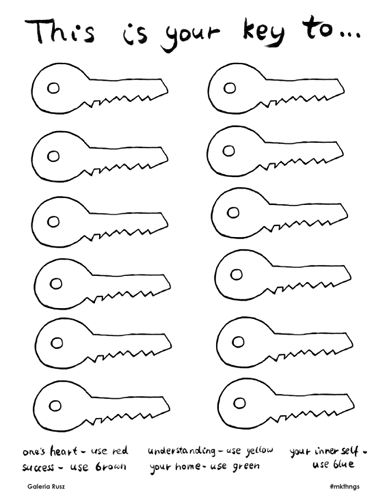
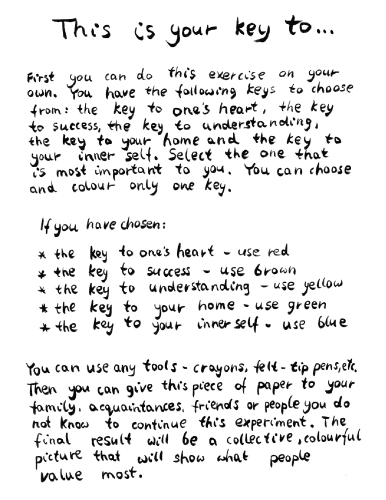
Download PDF.
This experiment helps individuals or groups of people see/realise what is most important to them and what they can concentrate on in their lives. Such awareness gives us a chance to improve our quality of life and satisfaction. It also helps us become happy people.
We do thinking art for thinking people. The way we think about reality has a particularly strong influence on the shape of the world we live in. For 15 years we have been using billboards to communicate with our recipients and persuade them to rethink their own lives, their own priorities, and the surrounding reality.
Galeria Rusz is an art group established by the two artists: Joanna Gorska and Rafal Goralski. Our main interest is the creation and presentation of art in public space. Since 1999, we’ve run our own billboard gallery in Toruń, Poland. We create billboard posters, paintings, and murals; and undertake artistic interventions and public art actions. galeriarusz.art.pl
Bean Gilsdorf
How to Use It
How to Use It is a brief overview. It tells you how.
I make artworks by collaborating with existing images, objects, and theoretical structures.
Bean Gilsdorf is an artist and writer. Her work has been included in exhibitions nationally and internationally. She is currently the Managing Editor of DailyServing.com and the Lead Interpreter for the Bean Gilsdorf Living History Museum in San Francisco. beangilsdorf.com
Sarrita Hunn
How to...Make an (Alternative) Institution
Inspired by Ad Reinhardt’s How to Look at Art series, How to...Make an (Alternative) Institution is an instructional activity cartoon that asks viewers to look at existing institutions in a new way, invent their own and negate those which are failing.
How to...Make an (Alternative) Institution is the first publicly presented project by the Institute for Autonomous Practices (IAP), a speculative organization whose primary function (like all institutions) is to perpetuate itself by focusing on two self-defining questions: What is an institution? and What is autonomy?
Sarrita Hunn is an interdisciplinary artist whose practice includes writing, arts administration, teaching and curating. Over the last decade, she has worked with many artist-run spaces across the globe from Andrea Zittel’s A-Z West in Joshua Tree, CA to Spor Klübü in Berlin, Germany. Additionally, she is the co-founder and managing editor of Temporary Art Review, Residency Program Director at The Luminary and Assistant Director of the Summer Institute for Visual Arts at Drury University. instituteforautonomouspractices.org
Maria Hupfield
Nay/Yea
Free cut-out coupons for answering 100% affirmative or negative.
I create hand-stitched human-scale sculptures that I often further activate in performance and video installation. I am curious about how we connect to our surroundings and are informed physically by our bodies and the items we carry on our person. These sculptures are based on everyday objects that I make in grey industrial felt, silver fabric and repurposed or modified materials.
Based in Brooklyn, Maria Hupfield is from Canada, of Anishnaabe (Ojibway) heritage and a member of Wasauksing First Nation, Ontario. A recipient of the 2013 Joan Mitchell Foundation Painters and Sculptors Grant, she has shown at the Museum of Art and Design NY, and Wave Hill Glyndor Gallery. Her current three-part performance, Artist Tour Guide, is commissioned by the Smithsonian National Museum of the American Indian (NY). mariahupfield.wordpress.com
Ariana Jacob
Since culture is the way we do what we do everyday, A conversation could be an art form
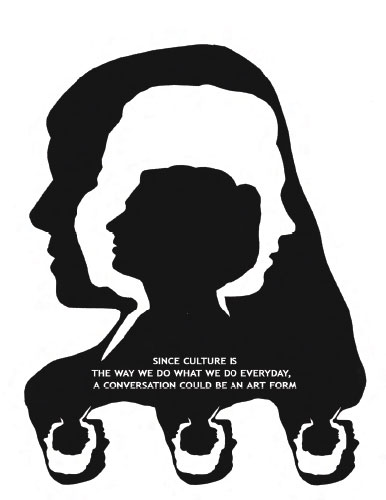
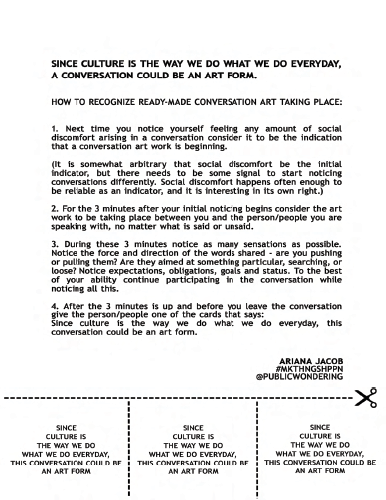
Download PDF.
You are invited to use this form to help yourself notice ready-made conversation art taking place—and to share that shift in perception with your talking companions.
I am for an art that makes us perceive everyday life differently. Talking with other people has always been one of the best ways I have found to shift how I perceive the world. Often this comes from the different ideas and understandings people have about our common culture. At the moment I am becoming interested in paying more attention to the emotional tones and social dynamics of conversations as another way of gleaning new perspective.
Ariana Jacob makes artwork that uses conversation as medium and as a subjective research method. Her work explores experiences of interdependence and disconnection, questions her own idealistic beliefs, and investigates how people make culture and culture makes people. Her work has been included in the Northwest Biennial at the Tacoma Art Museum, Disjecta’s Portland 2012 Biennial, The Open Engagement Conference and the Discourse and Discord Symposium at the Walker Art Center. publicwondering.wordpress.com
Hannah Jickling & Helen Reed
Mystic Pizza
Mystic Pizza is an ongoing relational artwork that explores everyday magic, agnostic spirituality, and collaborative meaning making. Mystic Pizza offers a system of reading pizza crusts, by borrowing basic tenets from divination practices such as taseomancy, cartomancy and palmistry. Divination can be viewed as a social form, where the reader and querant work together to assemble fragments of meaning. And pizza, a quintessentially social food, is the perfect vessel for this relational inquiry.
Helen Reed and Hannah Jickling have worked together since 2007. Their projects take shape as videos, public installations, social situations, events, photographs, printed matter and multiples. hannahjickling.com reheardregalement.com
Nick Lally
33434 Drawings
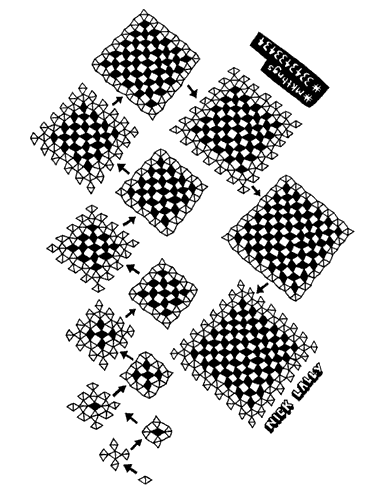
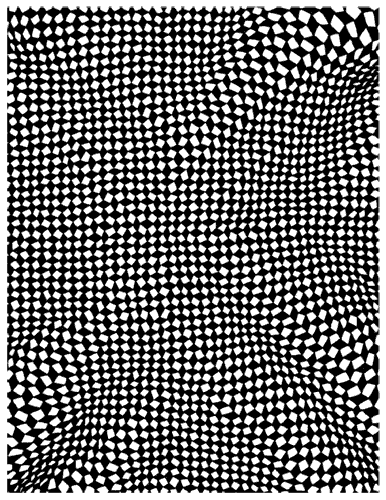
Download PDF.
Drawing mathematical patterns by hand based on a simple set of rules, as if we were computers executing algorithms, reminds us of the imprecision of our hands.
I get away from the computer by acting like I am a computer.
Nick Lally is an artist and programmer interested in digital media, collaboration, participation, radical political theory, mathematics, education, space, and bicycles. He lives and works in Oakland, California. nicklally.com
Justin Langlois
5 Provocations
5 Provocations offers a series of short open-ended prompts for imagining practices of collectivity, affinity, and gathering in support of transforming the world around us. Whether read as an instruction manual, a to-do list, or a manifesto, the prompts aim to implicate us, together, in considering the responsibility we share for one another.
My practice explores collaborative structures, critical pedagogy, and custodial frameworks as tools for enacting divergent possibilities for gathering, learning, and making. Artistic, curatorial, and design-based methodologies intersect in my research and creative activity to support my interests in gestural and tactical actions to generate critical public dialogue.
Justin A. Langlois is an artist, educator, and organizer working across media and social practices. He is the co-founder and Research Director of Broken City Lab and an Assistant Professor of Social Practice at Emily Carr University of Art and Design. justinlanglois.com
Justin Limoges
make things misshapen
I was thinking about Thek’s curiosity & appetites and Walser’s discipline & fiendishness when I wrote this. In the making things/happen realm, I’m interested in consequences, intended and otherwise.
I am interested in the intersection of complexity and concision.
I live in Oakland, CA, and make occasionally. justinjlimoges.com
Jessica Longmore
Build Your Own Studio
A set of instructions to build a studio. Instructions can be interpreted as required, making the studio adaptable to individuals and available space. How you choose to use your studio is your choice.
Jessica Longmore’s practice involves a series of appropriate gestures—instinctive sculptural responses to the psychology of particular spaces. Her recent focus has surrounded the idea of the studio being a form-er in the production of work, which has led her to spend single days creating work in other artists’ studios, using only the objects she encounters there (Objects For A Studio, 2008–ongoing).
Jessica Longmore is an artist and lecturer from Manchester, UK. She received an MA in Fine Art from Manchester Metropolitan University in 2007 and since then has exhibited locally and internationally. Jessica has taken part in residencies in the UK, France, The Netherlands and China. Forthcoming projects include a publication of her ongoing project Objects For A Studio. jessicalongmore.com
Mail Order Brides/M.O.B.
Manananggoogle Training Manual: Assuming The Right Position
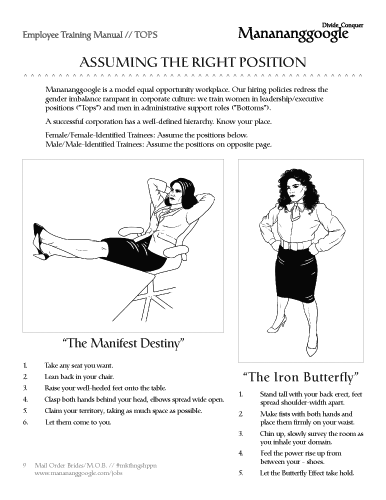
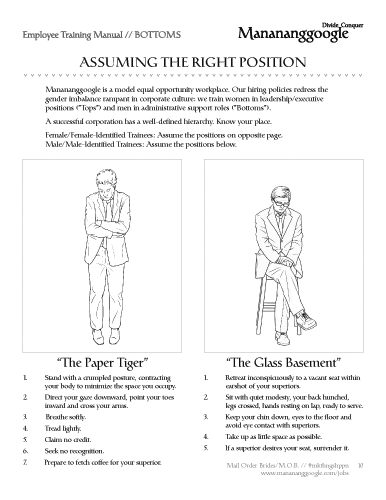
Download PDF.
This project excerpts two pages from The Manananggoogle Training Manual, part of Mail Order Brides/M.O.B.’s ongoing corporate venture, Manananggoogle. M.O.B. embody three intimidating lady executives at the helm of a formidable Silicon Valley corporation: these executives are also, however, feared to be the mythical Philippine manananggal—a terrifying forked-tongued bloodsucker. Manananggoogle was recently featured at the San Jose Museum of Art as well as San Francisco’s Southern Exposure art space.
Our M.O.B. personae are both cultural and gender drag: a way to explore tropes of Filipino and/or female identity from a place of high camp and serious critique. With collective/individual practices rooted in sculpture, installation, photography, video, drawing, and painting, we painstakingly craft the absurd realities we inhabit: karaoke music videos, museum makeovers, photographic psychodramas, parade performances, public service posters, professional bridesmaid services and corporate ventures.
Since 1995, Eliza “Neneng” Barrios, Reanne “Immaculata” Estrada, and Jenifer “Baby” Wofford have worked collaboratively as Mail Order Brides/M.O.B., a trio of Filipina-American artists engaged in an ongoing conversation with culture, ethnicity and gender. While other mail order brides are conventionally perceived as ideal obedient domestics, it has not escaped this trio’s attention that “Mail Order Brides” abbreviates down to a more sinister acronym that informs the darker subtext of their operations. manananggoogle.com
Kari Marboe & Erik Scollon
Make Words
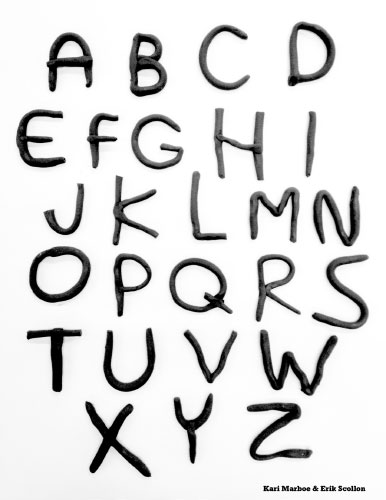
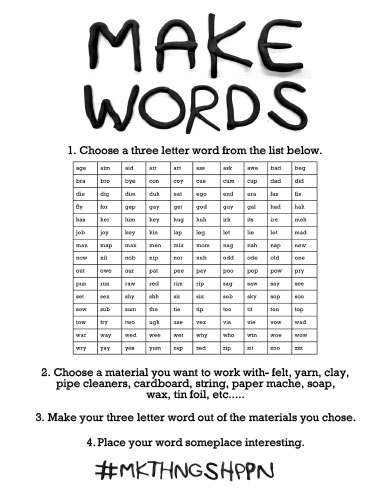
Download PDF.
Kari Marboe and Erik Scollon both teach ceramics, one at California College of the Arts, the other at UC Berkeley. They are both interested in tiny worm holes between art and the everyday. Make Words is an expansion of one of the projects they will be doing with their class this semester. You are invited to Make Words along with them.
Erik Scollon is an artist, educator and writer working in Oakland, CA. He earned his MFA from California College of the Arts and currently teaches ceramics at UC Berkeley. erikscollon.tumblr.com
Kari Marboe is is an artist, educator and writer working in Oakland, CA. She earned her MFA from UC Berkeley and currently teaches ceramics at California College of the Arts. karimarboe.com
Betty Marín
Be More Solidary
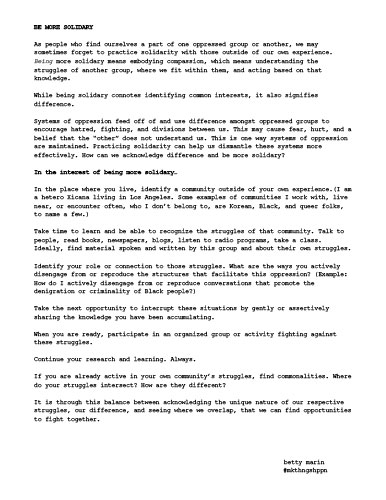
Download PDF.
As people who find ourselves a part of one oppressed group or another, we may sometimes forget to practice solidarity with those outside of our own experience. Being more solidary means embodying compassion, which means understanding the struggles of another group, where we fit within them, and acting based on that knowledge.
My practice uses research, education, and public interventions to investigate both the way we learn, as well challenge the beliefs that separate us from each other. Using art ultimately as a discursive and critical space, visual languages and objects are tools to push this dialogue. Recent work has focused on embedding conversations about experiences still debated in the mainstream, like the immigrant or undocumented experience, into more widely accepted sites in our society.
Betty Marín is an artist, educator, and social justice worker from Los Angeles, CA, where she is currently based. Her current research is focused on the history and current context for building solidarity between Brown and Black folks in Los Angeles. She received an MFA from Portland State University in 2014. cargocollective.com/bmarinluna
Mark Anthony Martinez
Thought Experiment
We are taught fear above all else; we walk around with lowered heads, ignoring the third root, hardening our faces at the sight of darker others. My most recent conversations with friends and family in my hometown of San Antonio serve as a constant reminder that we have a long way to go before we are free of hate and fear.
Mark Anthony Martinez is a firm believer in self-definition and the need to mark the familiar as decidedly particular. As such he defines himself as an Offwhite [tenuously latino, non-white, non-Black and non-affiliated indigenous], Cisgender, hetero-performing, male, interdisciplinary artist whose work interrogates the contemporary function of racial identity in US society.
Born in San Antonio, TX, Mark Anthony Martinez has lived, worked and exhibited in Portland, OR and Chicago, IL. In 2008, Martinez moved to Portland where he received his BFA in Intermedia at the Pacific Northwest College of Art (2011) and MFA in Contemporary Art Practice from Portland State University (2014). Martinez currently resides in San Antonio, TX. markanthonymartinez.com
Meta Local Collaborative
(how to) make friends, make a scene, make things happen, and fall in love with your neighborhood
(how to) make friends, make a scene, make things happen, and fall in love with your neighborhood is based on Meta Local’s ongoing project, Boogie Down Rides. Participants are invited to consider the act of riding a bike as a form of performance and community-engaged action.
Meta Local investigates the dynamics of urban spaces; exploring the histories of buildings and neighborhoods, and tracing the flows of people, ideas and products. Combining documentary strategies with performance and fine art, we articulate concepts of origin, and the sense of place.
Meta Local is the collaborative practice of Elizabeth Hamby and Hatuey Ramos Fermin. Ms. Hamby studied at Parsons School of Design and Eugene Lang College, and Mr. Ramos-Fermin holds degrees from the University of Puerto Rico and St. Joost Academy of Art and Design. Recently, Meta Local has participated in the Create Change Public Art Residency at the Laundromat Project, the Marfa Dialogues, and exhibited their work at the Bronx River Art Center. They are based in the Bronx. metalocal.net
Melissa Miller
Söl Lewitt
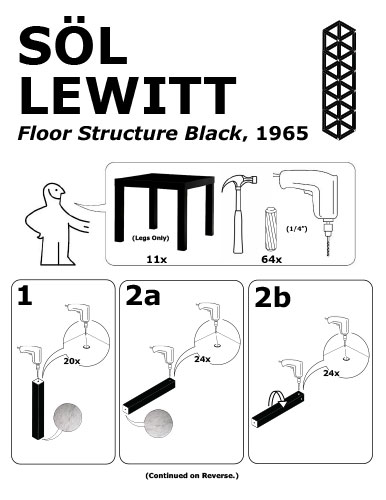
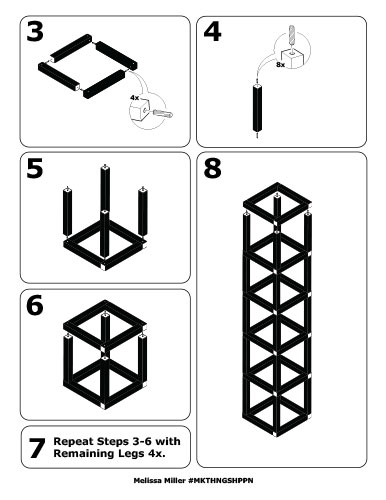
Download PDF.
In Söl Lewitt, I have provided the viewer with instructions for making Sol Lewitt’s sculpture Floor Structure Black from 1965 using the legs of Ikea Lack Side Tables. Minimalist artists were interested in the democratic value of stock manufacturing materials. In my version of Sol Lewitt’s sculpture, I have updated the production materials to reflect what might be considered a more contemporary ‘democratic’ building material.
By mixing the aesthetic language of post modern art movements (specifically, Feminism and Minimalism) with today’s pop-culture vocabulary, my work highlights the tension between the the past and and current period. Humor and parody fuel the critical transformations produced by my formal appropriation. By aesthetically referencing the past I am able to both recuperate and critique the politics of specific art and political movements.
Melissa Miller is an artist, writer and curator living in Oakland, CA. Melissa is currently pursuing her MFA in Studio Art and MA in Visual and Critical Studies at California College of the Arts in San Francisco. She received her BFA in Printmaking from the University of Oregon Robert D. Clark Honors College in 2011. melissamillerart.com
Roy Meuwissen
Sufficient Warning
The following instructions allow you to produce a copy of the ominous note that Tom Cruise receives in Stanley Kubrick’s final film, Eyes Wide Shut (1999) and deploy it for your own purposes, whether sinister or benign. Taken out of context, this portentous and disturbing provocation becomes a kind of absurd and unsolicited warning.
Working with a variety of media, including photography, video, text and installation, Roy Meuwissen’s work negotiates the recursive economy and affective power of images to create contexts for critically re-imagining the quotidian. He maintains an interdisciplinary and conceptually oriented art practice focused on the intersections between painting, cinema, architecture and post-studio practices.
Roy Meuwissen was born in the Netherlands and is currently based in Montréal, Canada. He holds a BFA from the Alberta College of Art & Design (1997) and a MFA from the University of Windsor (2003). He is currently a resident artist at the Darling Foundry in Montréal (2013-2015). roymeuwissen.com
Laura Napier
How To Make Things Happen
To make things with others requires finding common ground. Listening effectively, while utilizing communication technologies allowing physical remove, takes careful thought and planning. While messages are deceptively easy to send across long distances, it is easy to slip into an alternate virtual world where we do not truly not connect. I adopted this hierarchy working in the Bronx in 2006.
I work with people to stage site-specific social projects and collaborative group performances. Lately I am very interested in preexisting social groups, especially ones organized inside sites of former communities—where people lived or worked together. Usually these projects begin with primary and secondary source research, interviewing, collecting, and documenting, while thinking in terms of behavior, sociology, and place.
Laura Napier is a California born, Bronx based artist and independent curator. She moved to New York City in 1994 to study at Cooper Union. She recently organized a social performance of the Flint Male Chorus and the Flint City Wide Choir in Michigan, and brought her grandfather’s window cleaning business, Motor City Window Cleaning Co., to Memphis, TN. lauranapier.com
Susan O’Malley
Signs
I wonder if what I wrote can transport you somewhere. I hope it’s a good place.
I often use simple and recognizable tools of engagement—offering Pep Talks, asking for advice from strangers, installing roomfuls of inspirational posters—to offer entry points into the understood, and sometimes humorous, interactions of everyday life. I am interested in shifting ordinary exchanges into heightened experiences and rely on the back-and-forth between myself and others in the creation of the artwork.
Based in the San Francisco Bay Area, Susan O’Malley received her MFA from California College of the Arts’ Social Practice area. Her work has been exhibited throughout the Bay Area and internationally in Denmark, Poland, and London. She has received residencies at the Montalvo Arts Center, Saratoga, CA; the Parthenon Museum, Nashville, TN; and Kala Art Institute, Berkeley, CA. susanomalley.org
Dionis Ortiz
The Blue Collar Series
My work utilizes intricate drawing and painting methods infused into various printmaking techniques. Through these processes, I am able to weave a narrative based on the immigrant experience through the eyes of the blue-collar worker, who has not been able to achieve the American dream. I portray them in noble stances with dramatic cityscapes as their backgrounds, to be viewed in the same light as iconic figures.
My work utilizes both abstract and figurative painting styles. I believe that patterns, shapes and colors are the foundations of human creativity and I use them to sculpt my visual narratives. Among my strongest influences are artists whose creations speak to the struggles inherent in the human condition, including Romare Bearden, Charles White and Emmett Wigglesworth.
Dionis Ortiz is a visual artist and mural designer. A Harlem native, his work explores his dual identity as a New Yorker and a person of Dominican descent born to immigrant parents, and visually narrates interpretations of his experiences and surroundings through the use of landscape, symbols, text, as well as various mediums and painting techniques. In 2013, he was accepted into The Bronx Museum of the Arts Artist in the Marketplace (AIM) program. dionisortiz.com
Kristina Paabus
How to Make a Village Swing
How To Make a Village Swing is based on the Külakiik—a traditional Estonian, multi-person swing that harkens back to the country’s pagan roots, and is still an integral part of the culture today. In the summer of 2012 the collaborative team WITH (Matt Nichols and Kristina Paabus) built a village swing in Soldiers Grove, WI while at ACRE Residency Program. This diagram describes WITH’s social sculpture, which was designed from the study of, and participation with, Estonian village swings.
In my work I examine the systems of logic and order, which we as groups and individuals use to enforce perceptions of structure. With a multidisciplinary approach, I create hybrid spatial conversations that elaborate on the constructions that allow us to interact with, and gain control over, our surroundings. These specific systems, such as language, architecture, beliefs, and organizational tools, serve as guides to our relationship to the world around us.
Kristina Paabus has lived in only cold climates, ranging from the Northeast and Midwest to Estonia. She earned her BFA from Rhode Island School of Design and MFA from School of the Art Institute of Chicago. A visual artist with a multidisciplinary practice, Paabus is the recipient of a Fulbright Grant and has participated in many residencies and exhibitions. Currently she is the Grant Wood Fellow in Printmaking at The University of Iowa. kristinapaabus.com
Piero Passacantando
Breathe

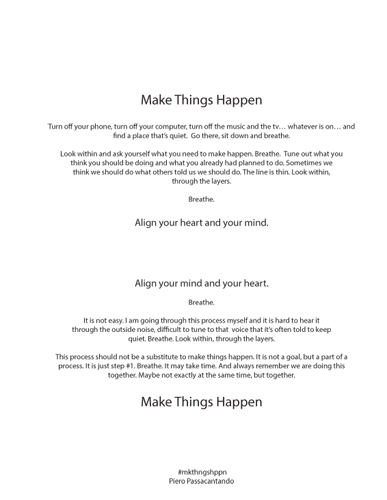
Download PDF.
This image and the text are meant to complement and reinforce each other. This piece is based on my current experiences with introspection and meditation.
Piero Passacantando is an interdisciplinary artist. He has focused on two main bodies of work: paintings and digital images exploring patterns, geometry and color; a series of workshops aimed at artistic research and discussion around the corporate office space.
Piero Passacantando is an interdisciplinary artist. Recently, he brought his project MyNerva to the EFA Project Space and he was a resident at Flux Factory. In 2012, Piero participated to AOIP and the DAF in NYC. In 2011, he was a Fellow at the Laundromat Project. He is a Fulbright Alumnus. He has an MFA from CCA. pieropassacantando.com
Julie Perini
Instructions for White People Fighting White Supremacy in the United States #1
As a white woman in the United States, most of what I have learned about race and white supremacy has come from listening to people of color. This project describes that process, and encourages other white people to become more conscious of whiteness.
I create experimental and documentary films/videos, installations, and events. My work often explores relationships between personal and political, public and private, fact and fiction. With Portland’s Safe & Sound? media collective, I have created community-based documentaries about the police and social justice. My personal diary videos often explore identity and representation, such as my recent series, White Lady Diaries.
Originally from Poughkeepie, NY, I have been exploring my immediate surroundings with cameras since age 15 when I discovered a VHS camcorder in my parents’ suburban home. I still use readily accessible technologies to make things happen in the world around me. I am an Assistant Professor in the School of Art + Design at Portland State University. julieperini.org
Ryan Pierce
Make an Entrance
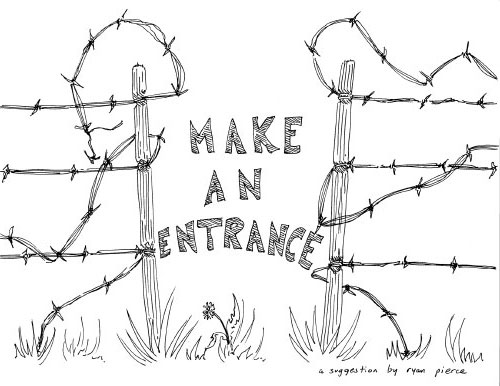
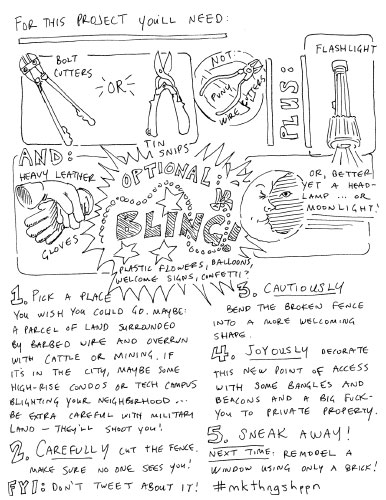
Download PDF.
In the U.S., and particularly in the West, we often take for granted a person’s right to surround an amount of land with what is essentially a weapon. Here’s an invitation to intervene.
I make art under the premise that climate change is unveiling a strange new version of our known world and that we will experience this mystery with equal parts dread and curiosity. I work in distinct series and contextualize most projects with self-published texts or sculptures, and increasingly rely on methods such as wilderness walks or scavenger hunts to exhibit my work in a participatory structure.
Ryan Pierce’s vivid, large-scale paintings depict our world recovering from human industry. He draws on influences from ecological theory, literature, and folk art to create scenes that portray the resilience of the natural world. Pierce is the co-founder, with activist Amy Harwood, of Signal Fire, a group that facilitates wilderness residencies and retreats for artists of all disciplines. ryanpierce.net
Pavel Romaniko
Do-It-Yourself Joseph Kosuth “One and Three Chairs” installation
The manual provides anyone with an opportunity to make their own a paper copy of Joseph Kosuth's One and Three Chairs piece first executed in 1965.
Pavel Romaniko constructs miniature sets of building interiors using construction paper. Although reminiscent of domestic interiors Romaniko photographed in his previous series of work, most of the photographs are not alway specific to actual locations but instead become symbolic reflections on exile, blurred memory, and explores the points of intersection between personal and cultural recollection.
Pavel Romaniko was born in Pereslavl-Zalessky, a small town outside of Moscow, Russia, in 1980. He came to the United States at the age of seventeen. Romaniko completed a BA in Studio Arts from Northwestern College in Saint Paul, MN (2002), and an MFA in Imaging Arts from the Rochester Institute of Technology (2009). Pavel works with a variety of media including photography, video, and installation. pavel-romaniko.com
Risa Puno
Connect the Dots—Personality Quiz
Connect the Dots is inspired by the recent flood of personality quizzes throughout social media. People are naturally curious about themselves, and social media has made it even easier to share and compare results. Loosely based on pop psychology theories, such as the right/left brain dichotomy and handwriting analysis, Connect the Dots is a fun, visual way to connect with others and spark a dialogue, both online and offline.
I make interactive installations and sculptures that play with elements of everyday life. The key to understanding my work is to physically engage with it — to use it, play it, touch it, smell it, and sometimes taste it. While I make every effort to craft objects that are beautiful and alluring, my main objective is to create evocative and memorable experiences for the people who use them.
Risa Puno has exhibited at venues including: The Aldrich Contemporary Art Museum, El Museo del Barrio, Socrates Sculpture Park, SculptureCenter, NURTUREart, Flux Factory, The Bronx Museum of the Arts, Galerie Stefan Röpke in Cologne, Germany, and MMX Open Art Venue in Berlin, Germany. She studied art and medicine at Brown University and earned her MFA from New York University. She grew up in Louisville, Kentucky where she fostered a love for miniature golf and all things deep-fried. risapuno.com
Genevieve Quick
How to See into the Past
This piece proposes that the simple act of looking can be a time traveling experience. While I use light, tree rings, and geology as examples, the residue of past events is evident in many everyday things.
I am interested in the way that light operates in the production of images and the way that visual technologies influence our ideas of opticality. As a strategy, I am interested in distilling seemingly complex optical phenomena and creating low tech approximations or analogies. I incorporate photography and video with my sculptures as documentation, process, and content.
Genevieve Quick is a San Francisco based artist and art writer. She has exhibited in Bay Area galleries and received an Investing in Artists Grant from the Center for Cultural Innovation and a Kala Fellowship. Quick has been awarded visual arts residencies at the de Young Museum, MacDowell, Djerassi, and Yaddo. She has contributed writings to Shotgun Review, The Present Group, and caa.reviews.org. genevievequick.com
Mary Rothlisberger
HOW TO HAVE A MOMENT
Make time don’t take time. Feel all the feels. Give me a go and I’ll give you a stay. The tragical magical notion of with. It all matters.
My work explores universal issues of relating to one another by sincerely engaging in site-specific action and encouraging an inclusive adventurous collective spirit.
Mary Rothlisberger is a citizen artist. She hails from the border town of Palouse, WA and spends most of her days taking the long way home back and forth across America. She loves small towns, long winters, optimists, parades, and the United States Postal Service. bangbangboomerang.com
Pallavi Sen
Please Mr. Postman
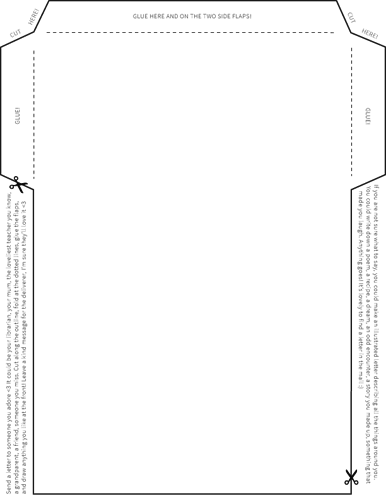
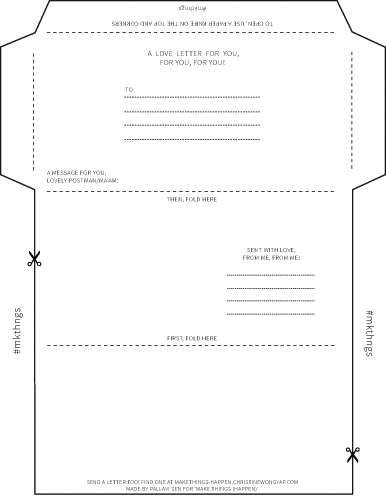
Download PDF.
A simple template for sending letters, Please Mr. Postman encourages communication that brings delight, builds anticipation, is rich in thought and sentiment, and makes both the sender and the recipient happier than before.
With craft and the history of decorative arts as my guide, I create installations disguises, rooms, books, patterns, and prints that explore beauty, sensuality, and spectacle.
Pallavi Sen is an interdisciplinary artist living and working in India. Since her graduation, she has worked as a bench jeweler, hammering gold; as a research intern at The Metropolitan Museum of Art, looking at beautiful tapestries and studying stained glass; and most recently as a designer and teacher with the Marpha Foundation, in a little village high in the Mustang Valley of Nepal. pallavi-sen.com
Elisabeth Smolarz
Five instructions for everyday performances for a shitty day
Five instructions for everyday performances for a shitty day is set of mini performances to be performed during the course of a crappy day.
I utilize the multidisciplinary forms of video, photography, sculpture and drawing to explore the social structures which constitute human interaction within a culture. In order to expose collective consciousness and patterns of behavior, I often ask strangers to become participants and collaborators in my performance-based projects.
Immigrating from Poland to Germany, Elisabeth Smolarz grew up on the cusps of two different cultures affected by a communist and democratic system. Consequently, she became involved in the idea of how consciousness and perception is formed by one’s surroundings.
Since then her work has been shown nationally and internationally—in venues such as The Bronx Museum, New York, Eyebeam Art + Technology Center, New York, the Sculpture Center and the 3rd Moscow Biennale among others. smolarz.com
Tattfoo Tan
Everyone is an Artist
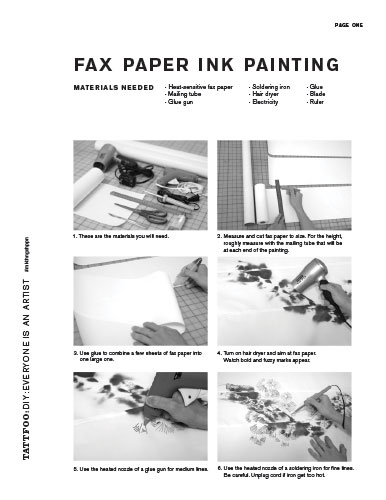
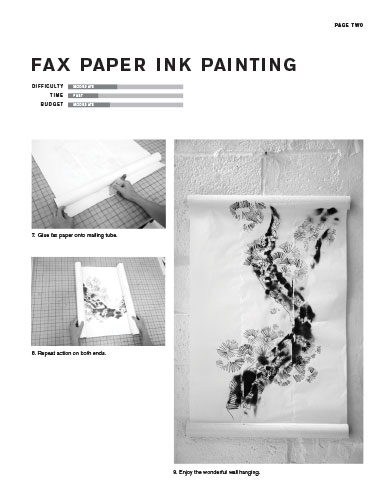
Download PDF.
Everyone Is an Artist is a printed poster that is distributed free to demystify the art-making process; it has step-by-step instructions, making art available, accessible and achievable. Once understood, the same techniques can be applied to various media, freeing the mind to create with simple and unpretentious materials. The project is a catalyst to art-making at home with family and friends.
Tattfoo Tan’s art practice responds to issues of ecology, climate change and nutrition. His unique art making process consists of learning new forms of knowledge, practicing them, and in turn teaching others. His decade long trilogy of projects: Nature Matching System, Sustainable. Organic. Stewardship. and New Earth had been shown widely and made into replicable manuals to inspire the public to take action.
Tattfoo is a self–taught artist who resides in Staten Island and has presented, collaborated on, published, and shown his works in various venues and institutions including The City of New York Department of Cultural Affairs Percent for the Arts, Parsons the New School for Design, 601Tully/Syracuse University, Creative Time Reports, Project Row Houses, Smack Mellon, Contemporary Arts Center (Cincinnati), Robert Rauschenberg Foundation, Ballroom Marfa, The Pulitzer Arts Foundation, and The Laundromat Project. tattfoo.com
Lauren Marie Taylor
Know and Believe
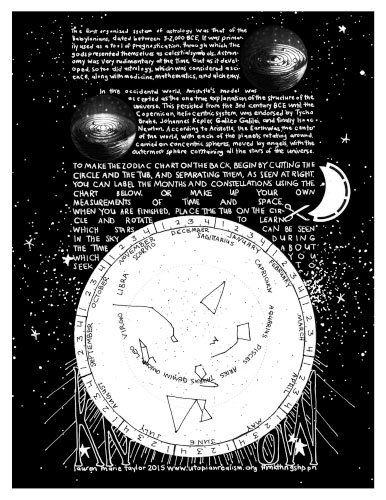

Download PDF.
Know and Believe allows you to construct a star chart in order to identify which stars and constellations will be visible in the night sky in a given time period. As you do so, please consider the historic relationship between astronomy and astrology, and the thoughts and ideas you've had that you now consider foolish. How do the foolish thoughts and ideas of others influence your opinion of them?
I am interested in futurity and all of its possibilities and potentials. I believe that by considering how we will survive in the future, we may improve our present condition, or at the very least, better understand its often ambiguous margins. My work generally takes the form of social practice, participatory, public, or community-based art, although this often manifests in a craft-based medium.
Lauren Marie Taylor holds an MFA from California College of the Arts, an MEd from Portland State University, and a BFA from the School of the Museum of Fine Arts Boston. She has recently finished a residency with the Vatican Astronomical Observatory. Recent projects include T-Minus Ten Minutes at Yerba Buena Center for the Arts. Her upcoming exhibition at Southern Exposure will share her research into robotics, science fiction, and civil rights. utopianrealism.org
sharita towne
10 Conceptual Film Prompts
These prompts come out of some of the questions I’ve had the past few years. I’ve been asking myself: Why is there unspoken rule among Black people on the street to acknowledge each other? How does the white racist mind work? How is being online changing how we look for answers? How do families share stories? How can I collaborate with other artists and audiences?
Our past burdens give shape to what worlds we may build, now and in the future. I’m interested in unpacking these burdens, in understanding how they mold our present selves, and in giving rise to collective catharsis. To this end I’ve worked at former concentration camps and memorials in Germany, in Saharawi Refugee camps, in favelas and cultural centers in Brazil, within my own family, in education, printmaking, video, stereo-photography, translation, and socially engaged art.
I’m an artist, teacher, sister, polyglot, and friend.
“Self Praise is scandalizing.” —Parthenia Fair Helms (my Grandmother) (my Father’s Mother)
“You are what you are when you’re hatched.”
—Harland Dean Towne (my Grandfather ) (my Mother’s Father)
cargocollective.com/sharitatowne
Emilio Vavarella
The Family Re-Coded
The Family Re-Coded is a a collaborative photographic glitch series based on my photographic series: The Sicilian Family (2013), sourced from my family’s collection of photographs. It’s a work about memory, error, family, and media. It proposes an open and conceptual technique for writing memories inside the code of a digital photo. This alteration forces the memories to coexist with the image, in an unforeseeable and new way.
My work is based on issues of political philosophy with a particular emphasis on the aesthetics of error and biopolitics. My work is informed by the history of conceptual art and new media practices. Using photography or other media, I highlight the ambiguous spaces of power, such as unexpected errors and unpredictability. I believe that by doing so, the intrinsic logic and hidden structures of power are revealed and an intellectual resistance is formed.
Emilio Vavarella was born in Italy in 1989. He has studied in Italy, Spain, Israel and Turkey. His work is based on issues of political philosophy and contemporary technological power and has been shown internationally. Most notably, he has recently exhibited at Eyebeam, EMAF, Currents, Mediterranea16, Fondazione Marangoni, GLITCH Festival, Boston Cyberarts gallery, Jarach Gallery and Bevilacqua La Masa. His work has been featured in Wired, the Huffington Post, and FlashArt, among others. emiliovavarella.com
David Gregory Wallace
Shadow Puppet Machine
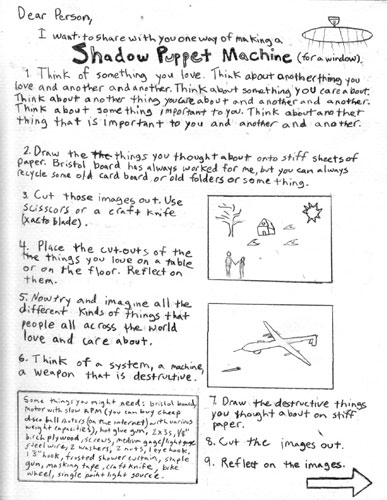
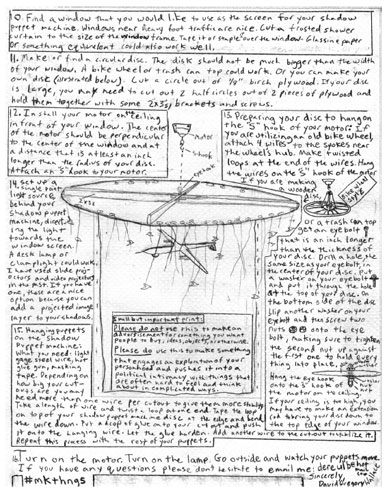
Download PDF.
This project provides instructions on how to make a shadow puppet machine as well as asking people to reflect on our shared vulnerability.
Through videos, installations, and shadow puppet machines, my work engages the power structures of remote warfare, surveillance, and state violence by bringing them into contact with issues of vulnerability and community.
David Gregory Wallace received his MFA in 2011 from the University of California, Berkeley. He has exhibited at the Berkeley Art Museum, Sonoma State Gallery, and Krowswork Gallery. His most recent solo exhibitions include Eye In The Sky (2012) at Right Window Gallery in San Francisco, CA, and Friends, Family, Neighbors (2013) at the Royal NoneSuch Gallery in Oakland, CA. He is currently participating in the AIM Program at the Bronx Museum of the Arts. davidwallaceprojects.org
Lexa Walsh
Facilitate a Meal and a Community Cookbook
Meal Ticket is an ongoing series of luncheons with different groups of people to foster democracy, community, and storytelling. Sitting down to a meal together is a basic act of humanity, however simple or extravagant. Through the discussion of recipes—a set of instructions—we discuss our cultures, families, and belief systems. I propose we are all equals in the temporary utopia of a luncheon, while fitting into the rich legacy of Community Cookbooks.
I work as anthropologist, archivist, collaborator, experience maker, explorer, facilitator, and participant. The essence of my work is situated in performance and direct engagement, bringing together members of the public to share in conversation, cheer, song, play, dance, and food. These participatory public projects propose the idea of hospitable democracy.
Lexa Walsh is an interdisciplinary, socially engaged artist based in Oakland, CA working with food, music, and play to create hospitable democracy. Walsh has lived, worked, exhibited and toured internationally. She was recently Artist in Residence at Portland Art Museum, Community Artist in Residence at Atlantic Center for the Arts, and is currently Artist Fellow in San Francisco’s de Young Museum. lexawalsh.tumblr.com
Alex Wilde & Emily Chappell
Stone Soup
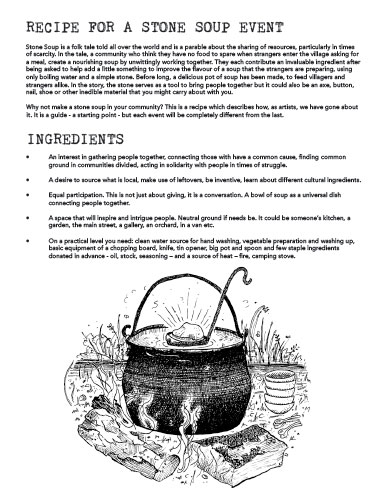
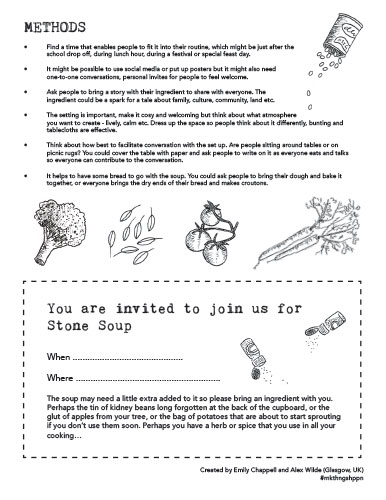
Download PDF.
Stone soup is a folk tale that can be interpreted in different ways but our interpretation is of the stone as a tool for collaboration with community. The tale can serve as way to frame a creative event, to capture people's imagination and draw them in and to provide a platform for conversation.
Alex and Emily as part of their work with Open Jar Collective deliver collaborative creative projects that range from hosting communal meals and staging unique pop-up events to research, workshops and exhibitions. Food is a vehicle for bringing people together, as a common language to understand the global economic system, and as a tool for exploring people’s fundamental relationship to the land.
Alex Wilde is a visual artist who graduated from Environmental Art at the Glasgow School of Art in 2001. alexwilde.info
Emily Chappell is an illustrator and designer with a BA in Visual Communication from the Glasgow School of Art. emilychappell.com
They are based in Glasgow and are both members of the Open Jar Collective, often collaborating on socially-engaged projects about the growing and eating of food, most recently for the Glasgow International Festival of Visual Art 2014.
Brian Zegeer
Dissonance Therapy
Dissonance Therapy is a completely un-scientific experiment that seeks to temporarily trigger sensory fragmentation in the participant in order to suggest the possibility of two simultaneous minds. This process is considered ‘therapeutic’ in that it might soften the structures of guilt, social anxiety, and loneliness by presenting the person to be a loose grouping of collaborative identities and semi-conscious diagnostic algorithms.
I use stop-motion animation as a means of uncovering the narratives embedded in objects and environments. For the past several years, I have studied the contemporary geography of the former Arabic Quarter in Lower Manhattan, or ‘Little Syria.’ Using Ameen Rihani's 1911 novel, The Book of Khalid, as a visionary framework, I attempt to trace correspondences between the sleek glass high rises that now occupy the site, and the grandiose aspirations of early 20th century Lebanese-American immigrants.
Brian Zegeer was born in Lexington, KY. His videos encounter the Appalachian and Lebanese landscapes of his parentage as highly-charged networks of affiliation and group narrative. He received his MFA from the University of Pennsylvania, attended Skowhegan School of Sculpture and Painting in 2010, and has recently shown at The Queens Museum, The Delaware Art Museum, The Jersey City Museum, Louis V. ESP, Regina Rex, Elga Wimmer Gallery, and Stephan Stoyanov Gallery. Zegeer lives in Brooklyn. brianzegeer.com
Lu Zhang
make a line, use a line, fix a line
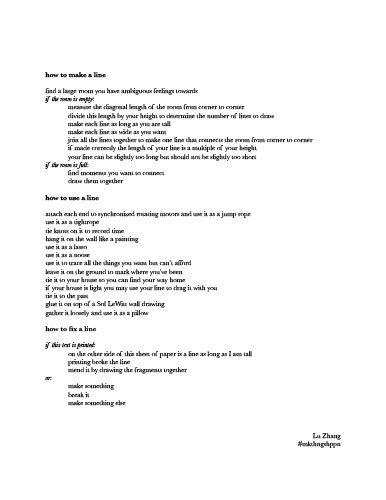
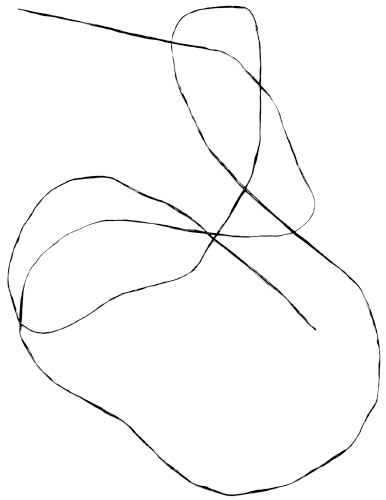
Download PDF.
The instructions of make a line, use a line, fix a line oscillate between the material, the poetic, and the impossible. The resulting drawing is a collaboration between myself, the reader, and a printer / xerox machine.
Lu Zhang is an interdisciplinary artist based in Baltimore. She received her MFA from Frank Mohr Institute in the Netherlands and her BFA from Maryland Institute College of Art. Her work has been exhibited in the United States, France, and the Netherlands. Lu recently became an inaugural recipient of a Rubys Artist Project Grant. She’s currently producing a site-specific book and installation to be housed in the George Peabody Library. lu-zhang.com
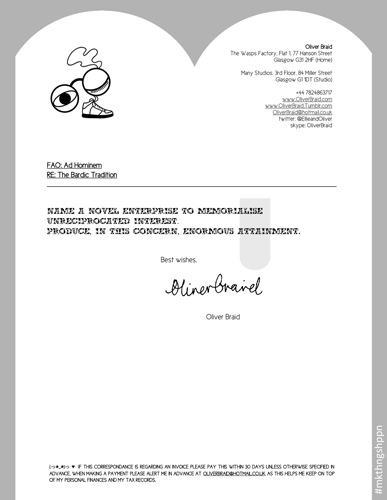
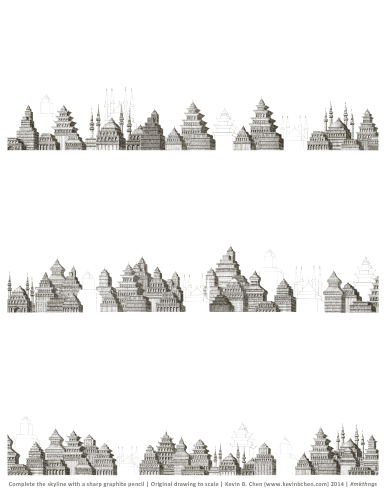
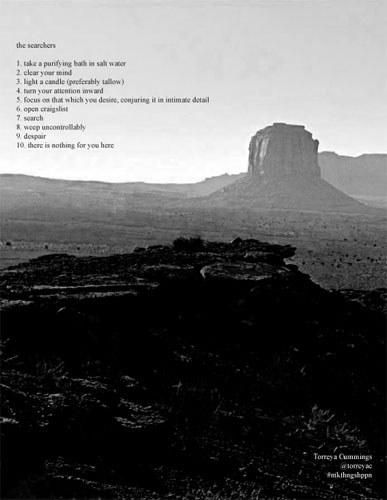
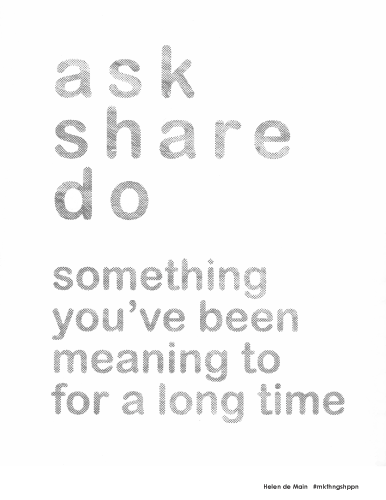
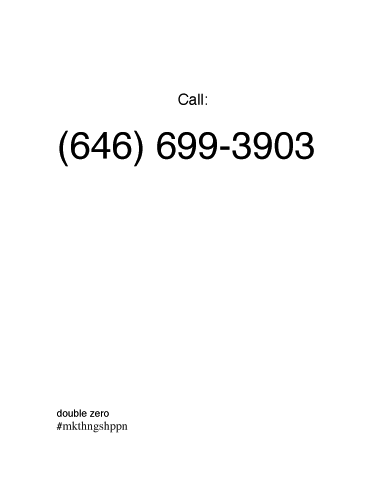
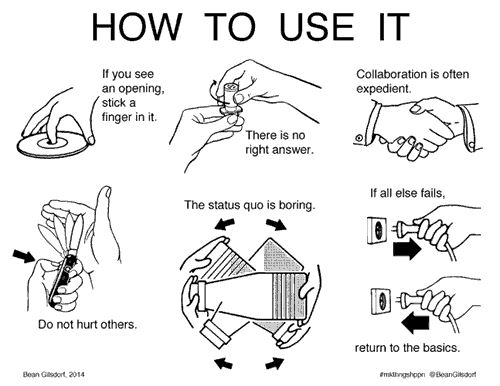
![Sarrita Hunn, How to...Make an (Alternative) Institution. HOW TO...MAKE AN (ALTERNATIVE) INSTITUTION. [a counter-power strategy] UNDERSTAND: COOPERATION: NONCOOPERATION: What is an institution? Make your own institution. Radical non-participation. (or support your local alternatives) Resist and destroy the failing system. Express your SOLIDARITY and help alternatives become the prevalent institutions by: BOYCOTT: Boycott most or all corporate products. Reduce to eliminate your consumption of gasoline. Close accounts and reinvest in local credit unions. STRIKE: Take your vacation time, sick leave. Orga- nize to strike. Spend time with friends and family! SELF-RELIANCE: Learn about wild foods. Start a garden. Increase your awareness of local market resources and strategies.4 Intitutions may be: FORMAL: U.S. Congress, Roman Catholic Church INFORMAL: marriage, family, money While institutions may seem static, they are in fact social constructs produced by collective human actions (toward a specific purpose). We understand these institutions (or organizations) through implicit images, or metaphors. “The use of metaphor implies a way of thinking or a way of seeing that prevade how we understand our world generally.”1 But METAPHORS always create distortions. 1. Morgan, Gareth. Images of Organization, Sage Publications, Inc., 1997 Organizations as... Our failing institutions are based on: market capitalist economy, authoritarian republics, patriarchy, eurocentricity Alternative institutions by necessity are based on: decentralized cooperative economics, participa- tory democracy, gender equality, ecology2 Through building alternative institutions, individuals are empowered, committed to change, and skilled in running society.3 COUNTER-POWER INSTITUTIONS: worker cooperatives, intentional communities, temporary autonomous zones 2. “An Introduction to Dual Power Strategy” by Brian A. Dominick 3. http://en.wikipedia.org/wiki/Dual_power MACHINES: factories, fast-food repetition BRAINS: bureaucracies, info systems ORGANISMS: technology, research PSYCHIC PRISONS: rules, behavior GAMES: politics, marketing outcomes ? (fill in your organizational metaphor here) INSTITUTE FOR AUTONOMOUS PRACTICES for #mkthngshppn - www.instituteforautonomouspractices.org open-ness processing decisions stability communication 4. https://www.facebook.com/pages/ Global-Strike-Real-Solidarity/ 116810318421903 REMEMBER: THEY HAVE AS MUCH POWER AS WE BELIEVE IN THEIR MONEY. -Global Strike needs compliance equilibria structures cooperation Photo: Janelle Orsi www.theselc.org conflict adapt projects learning de-humanzing power players health precision anxiety control survivial](../../../images/projects/2014_makethingshappen/hunn-mth-386x500.jpg)
